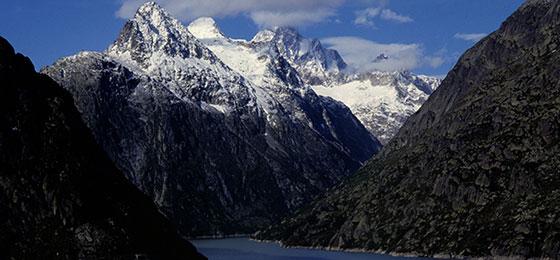Swiss hydropower: new potential, more challenges

In future, hydropower will need to provide more electricity. The NRP “Energy” calls for new economic approaches and greater ecological considerations.
In future, hydropower will need to provide even more electricity. This will be possible as due to the melting of glaciers new reservoirs could emerge, while the heightening of dam walls also offers potential. However, the sector is suffering. The National Research Programme “Energy” concludes that new economic approaches are required – with ecological considerations playing a greater role at the same time.
The hydropower sector finds itself in a conflict situation: on the one hand, it should be profitable and make a major contribution to the implementation of Energy Strategy 2050. On the other, it needs to take account of concerns relating to the protection of nature and landscapes. “Even in view of the tensions between political, economic and environmental interests, the Swiss hydropower sector must and can remain a cornerstone of the energy system”, says Tony Kaiser in summarising the key message from the now published synthesis on “Hydropower and Market”. As part of the National Research Programme “Energy”, several projects have investigated the technical, socio-economic, environmental and climate-related developments relevant for hydropower. The conclusions derived on this basis have now been published in the synthesis on “Hydropower and Market”.
Examine potential for new reservoirs in periglacial zones!
According to estimates, reservoirs situated beneath retreating glaciers could increase electricity production in Switzerland by around 3%. Approximately half of these could contribute to seasonal storage and thus to electricity production during the winter. This was the finding of a study conducted by ETH Zurich, which identified the seven locations best suited for the establishment of new reservoirs from those sites that are generally considered for this purpose. Their theoretical storage capacity stands at 1.3 TWh, which equates to 14% of the storage capacity offered by existing reservoirs. Compromises with respect to the protection of nature and landscapes will need to be examined.
Re-establish and preserve biodiversity with new measures!
The Waters Protection Act of 1992 provides the cantons with certain discretionary powers in assessing economic interests and applying exceptions. According to the research results, however, the only moderate implementation of the residual flow regulations in rivers situated beneath dams does not suffice for the re-establishment and preservation of biodiversity in regulated waters. The maintenance of natural discharge dynamics as well as occasional, natural or artificially triggered floods and appropriate bedload management are prerequisites for the preservation of biodiversity. In principle, the Waters Protection Act allows the cantons and the Federal Council to enforce environmentally friendly solutions – for example, with compensation areas.
Base water fees on earnings!
Flexible and earnings-based water fees are now deemed to be more in line with the market than fixed maximum values that are solely dependent on gross capacity, i.e. not on the electricity actually produced. Flexible, earnings-based water fees should therefore be introduced that are structured according to the principles of revenue sharing between the resource owners, i.e. the municipalities, and the power plant operators. To this end, complete transparency with respect to earnings figures is required. Regional policy and regional economic aspects should also be taken into account.
Conduct stakeholder dialogue with an integrated sustainability assessment for new hydropower projects!
Projects in connection with the construction or renovation of power plants as well as plans relating to new water fee regulations or the awarding of concessions should be prepared together with all stakeholder groups as part of a joint planning process and the groups’ respective interests should be weighed up against one another. The individual criteria are assessed by experts, while the stakeholders develop the “trade-offs”.
